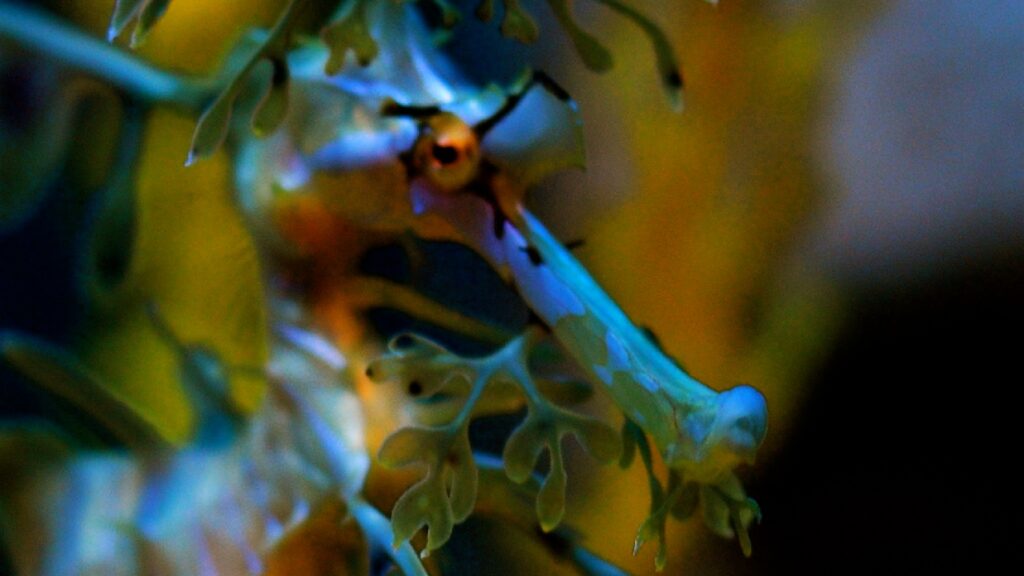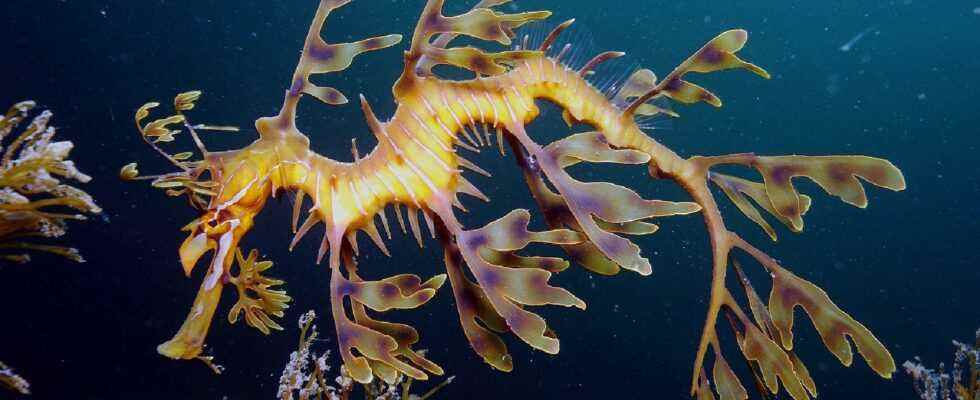Leaf seahorses (or “leafy sea dragons”) are vastly different from seahorses with their protuberances resembling lumps of algae. These distinctive signs, obtained quickly on the scale of evolution, are a scientific curiosity that well deserves to delve into their genome.
The seahorse is the star of our oceans. But there is a cousin species, less known, even more whimsical: the leaf seahorse (also called “leafy sea dragon”). It’s not hard to imagine what the name earns it: although it has all the characteristics of a seahorse, it also looks, quite literally, like a leaf or seaweed.
Its curious appearance isn’t the only surprising thing about the leaf seahorse. Individuals of this species have no teeth, no ribs, a particularly elongated face, and their spines are all twisted. They are experts in camouflage: in addition to looking like algae (otherwise they would be easy prey), their color can change slightly, under certain circumstances. What’s more, it is the males who take care of the embryos — laid by the females and then deposited on the male’s tail, which incubates them until they hatch.
But why are leaf seahorses so distinct among fish? To have a beginning of explanation, it is necessary to dive into their genetic code. This is what a team of biologists did, before publishing their findings on June 22, 2022 in the scientific journal PNAS. She describes the biology of this species as ” extravagant “. And for good reason, ” sea dragons are oddballs in an already oddball group of fish “, laughs Clay Small, one of the authors, on the site of the University of Oregon.
The whimsical genes
By sequencing the genome of two specimens, these scientists were able to unearth truly distinctive genetic characteristics compared to other fish. Among the peculiarities, there is simply a group of missing genes, yet usually present in vertebrates. These are not just any genes: they participate in the development of the face, teeth, appendages and part of the nervous system.

Conversely, the authors found in their genome a very large number of transposons, also called “jumping genes”, because they change position, duplicate themselves in repetitive sequences and can thus cause rapid mutations – which may be the cause evolutions or dysfunctions. These genes make up more than half of their genome, which their authors describe as ” surprising “.
To clarify whether or not this discovery was unique, they compared their genome with that of 16 species of teleosts – the class to which the overwhelming majority of fish belong. They conclude that, yes, the difference is notable given that the genomes of the leaf seahorses studied are ” unusually bloated with repetitive DNA among teleosts, for their relatively compact size “. The density is also high on all the chromosomes, when, in other species, these genes are either of a high density but grouped in hotspots at key locations; or they are of low density but uniformly distributed.
Evolution and its surprises
The authors did not stop at the genome. To dig even deeper into the secrets of these sea dragons, they imaged a specimen using a high-resolution X-ray microscope. ” No one had ever imaged part of a sea dragon like this, with such high resolution “, welcomes Susie Bassham, co-author of the study.
The scans revealed that the growths resembling pieces of leaf developed from thorns. ” This helped support the idea that these ornaments were derived from spines during evolution. »
Because, yes, leaf seahorses embody the complex speed of evolution. Leaf seahorses are believed to have evolved from seahorses “only” 50 million years ago, a particularly short time on a planetary scale to develop such notable differences while being two related species. Beyond even the scientific curiosity represented by these leafy seahorses, they therefore represent a marvelous case study of certain mechanisms of evolution. ” There’s a lot of interest in the malleability in the evolution of things like the head and the face. “says Susie Bassham.
